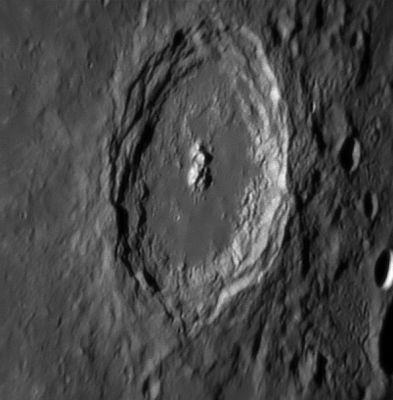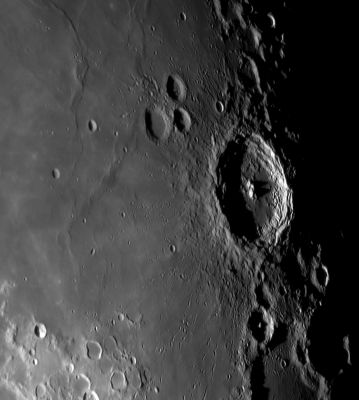Langrenus
Contents
- 1 Langrenus
- 1.1 Exploring the selenographic wonders of the Langrenus region
- 1.2 Images
- 1.3 Maps
- 1.4 Description
- 1.5 Flattenings on the moon's eastern limb
- 1.6 Wikipedia
- 1.7 Additional Information
- 1.8 Orbital observations of rusty colored spots in Langrenus (Apollo 14, 1971)
- 1.9 Chain of secondary craters between Langrenus and Vendelinus
- 1.10 Audouin Dollfus's possible Transient Lunar Phenomenon in Langrenus
- 1.11 Nomenclature
- 1.12 LPOD Articles
- 1.13 Lunar 100
- 1.14 Bibliography
Langrenus
|
Lat: 8.86°S, Long: 61°E, Diam: 131.98 km, Depth: 4.5 km, Rükl: 49, Eratosthenian | |
Left: Mark Crossley, Right: Mick Hyde
Exploring the selenographic wonders of the Langrenus region
The trio of craters northwest of Langrenus were once called Baker, Livingstone and Stanley by William Radcliffe Birt and John Lee. However, one of these three craters received the name Aller by Hugh Percy Wilkins and Patrick Moore. Another one of the three was called Vally (or Wally) by Felix Chemla Lamech. Today these three craters are officially known as Atwood, Bilharz and Naonobu. What was wrong with the names Baker, Livingstone and Stanley?Note: before the arrival of both Birt and Lee with their Baker-Livingstone-Stanley triplet of names, this trio of craters seems to have been called S. Bedae by Michel Florent Van Langren and Insula Minor (Small Island) by Johann Hewelcke, while M.F.Van Langren's Langrenus was temporarily J.Hewelcke's Insula Major (Large Island). Van Langren called the smooth low-albedo region northwest and southwest of his "own" crater (Langrenus) the "Sea of Van Langren" (Mare Langrenianum).
Giovanni Baptista Riccioli would call this region the "Sea of Fruitfulness" (Mare Fecunditatis). The northern part of it would become one of the moon's most photographed areas, this during the missions of NASA's Apollo program (1968-1972).
Images
LPOD|Photo Gallery images Lunar Orbiter Images Apollo Images
Maps
(LAC zone 80C1) LAC map Geologic map LTO map
Description
T.G.Elger:
(IAU Directions) LANGRENUS.--This noble circumvallation, the most northerly of the meridional chain of immense walled-plains, extending for more than 600 miles from near the equator to S. lat. 40 deg., would, but for its propinquity to the limb, rank with Copernicus (which in many respects it resembles) among the most striking objects on the surface of the moon. Its length is about 90 miles from N. to S., and its breadth fully as much. In shape it approximates very closely to that of a foreshortened regular hexagon. The walls, which at one point on the W. rise to an altitude of nearly 10,000 feet, are continuous, except on this side, where they are broken by the interference of an irregular depression, and on the extreme S., where they are intersected by cross-valleys. Within, the terraces are remarkably distinct, and the intervening valleys strongly marked. The brilliant compound central mountain rises at its loftiest peak to a height of more than 3000 feet. On the N. of it is an obscure circular ring, which may possibly merely represent a fortuitous combination of ridges, though it has all the appearance of a modified ring-plain. On the Mare, some distance N.W. of the formation, is a group of three ring-plains, with two small craters (associated with a ridge) on the N. of them. Two of the more easterly of these objects have prominent central mountains, and the third a very dark interior. At least three bright streaks originate on the W. flank of Langrenus, which, diverging widely, traverse the Mare Foecunditatis.
Flattenings on the moon's eastern limb
- About thirty years ago, the Rev. Henry Cooper Key drew attention to certain flattenings which he had noted on the E. limb, which are very apparent under favourable conditions of libration. Their position cannot be closely defined, but the principal deviation from circularity extends from about S. lat. 10 deg. to the region on the limb opposite the S. border of the Mare Crisium.
Wikipedia
Additional Information
- IAU page: Langrenus
- Depth data from Kurt Fisher database
- Pike, 1976: 4.5 km
- Westfall, 2000: 4.5 km
- Viscardy, 1985: 2.6 km
- Cherrington, 1969: 4.93 km
- Central peak composition: GNTA1, AN & T (Tompkins & Pieters, 1999)
- Central peak height
- Sekiguchi, 1972:
- Alpha: 3.5 km
- Beta: 3.0 km - fatastronomer fatastronomer
- Sekiguchi, 1972:
- Exterior impact melt deposits most extensive to SSE, max of ~50 km beyond rim. Most extensive ejecta, rays and secondary craters to the SSE, and topographically lowest rim crest to SSW and NW (Hawke and Head, 1977).
- Included in ALPO list of bright ray craters
- Satellite craters Langrenus G and M are on the ALPO list of banded craters
- Langrenus and Langrenus C, FF, M & P are thermal anomaly craters, implying youthful ages - Moore et al, 1980
- TSI = 35, CPI = 20, FI = 25; MI =80 Smith and Sanchez, 1973
Orbital observations of rusty colored spots in Langrenus (Apollo 14, 1971)
- According to NASA's book Apollo 14 Preliminary Science Report, there should be a color anomaly in Langrenus. Page 275: “A distinct rusty color is evident in one of a group of smooth bulbous domes with single or multiple furrows at or near the crests” (on the eastern wall of Langrenus).
Chain of secondary craters between Langrenus and Vendelinus
- A small "overlooked" chain of secondary craters between Langrenus and Vendelinus was imaged by Joseph H.C. Liu and published in the Summer 2006 issue of Selenology: Journal of the American Lunar Society. - fatastronomer fatastronomer
Audouin Dollfus's possible Transient Lunar Phenomenon in Langrenus
- Possible TLP (Transient Lunar Phenomenon) in Langrenus, observed by the French astronomer Audouin Dollfus on December the 30th, 1992. Mentioned in the book Epic Moon by W.P.Sheehan and T.A.Dobbins (2001).- DannyCaes Jun 6, 2014
Nomenclature
- Named for Michael Florent van Langren (circa 1600 – 1675), a Belgian astronomer and cartographer. Van Langren is noted for publishing in 1645 an engraving which is generally regarded as the first map to assign names to the features on the Moon visible through a telescope. Van Langren's nomenclature was a mix of generic Latin terms, names of current and ancient scientists and philosophers, and the names of contemporary royalty assigned to prominent features in capital letters. Two years later, Johannes Hevelius' much more influential lunar survey supplanted Van Langren's system with a completely different set of terrestrial-analog geographic names. However, in later years Hevelius's proposals were themselves largely replaced by a system, close to Van Langren's, introduced by Riccioli in 1651. Riccioli re-used many of Van Langren's scientist and philosopher names (although almost never for the same features) as well as his system of calling the dark areas "mare" (one of the few features embraced by Hevelius) and the bright areas "terra", but again with different names.
- The names that appear on Van Langren's engraving are listed in Appendix D (pages 195-200) of Whitaker's book, along with, in earlier appendices, the somewhat different names appearing on a manuscript version and the slight changes made in various "states" of the final engraving. Whitaker's list includes what he feels are the modern identities of the features named, although there must, of course, be much uncertainty about what Van Langren intended to represent by some of the minor markings. - Jim Mosher
- In the 1645 engraving, Van Langren named the present crater "Langreni" (after himself, one assumes).
- Riccioli modified the name to "Langrenus" in 1651. It has not been changed since.
- According to the Appendices in Whitaker, this is one of Van Langren's trio of oldest names in continuous use at a given location. - Jim Mosher The other two of Van Langren's anchored trio are Endymionis (IAU: Endymion) and Pythagorae (IAU: Pythagoras). - DannyCaes May 14, 2017
- Langrenus is also one of the very few instances in which a map maker has named a specific feature after himself and that choice has been honored by later map makers. Riccioli is perhaps the only other example. - Jim Mosher
LPOD Articles
Langrenus A Penchant for Names Four in a Row Moving Eastward Bands (Langrenus M) Dark Rays, Dark Streaks
Lunar 100
L85: Aged ray system.
Bibliography
Apollo Over the Moon, Chapter 5: Craters (Part 6), Figure 169.
Named Featues -- Prev: Langmuir -- Next: Lansberg

